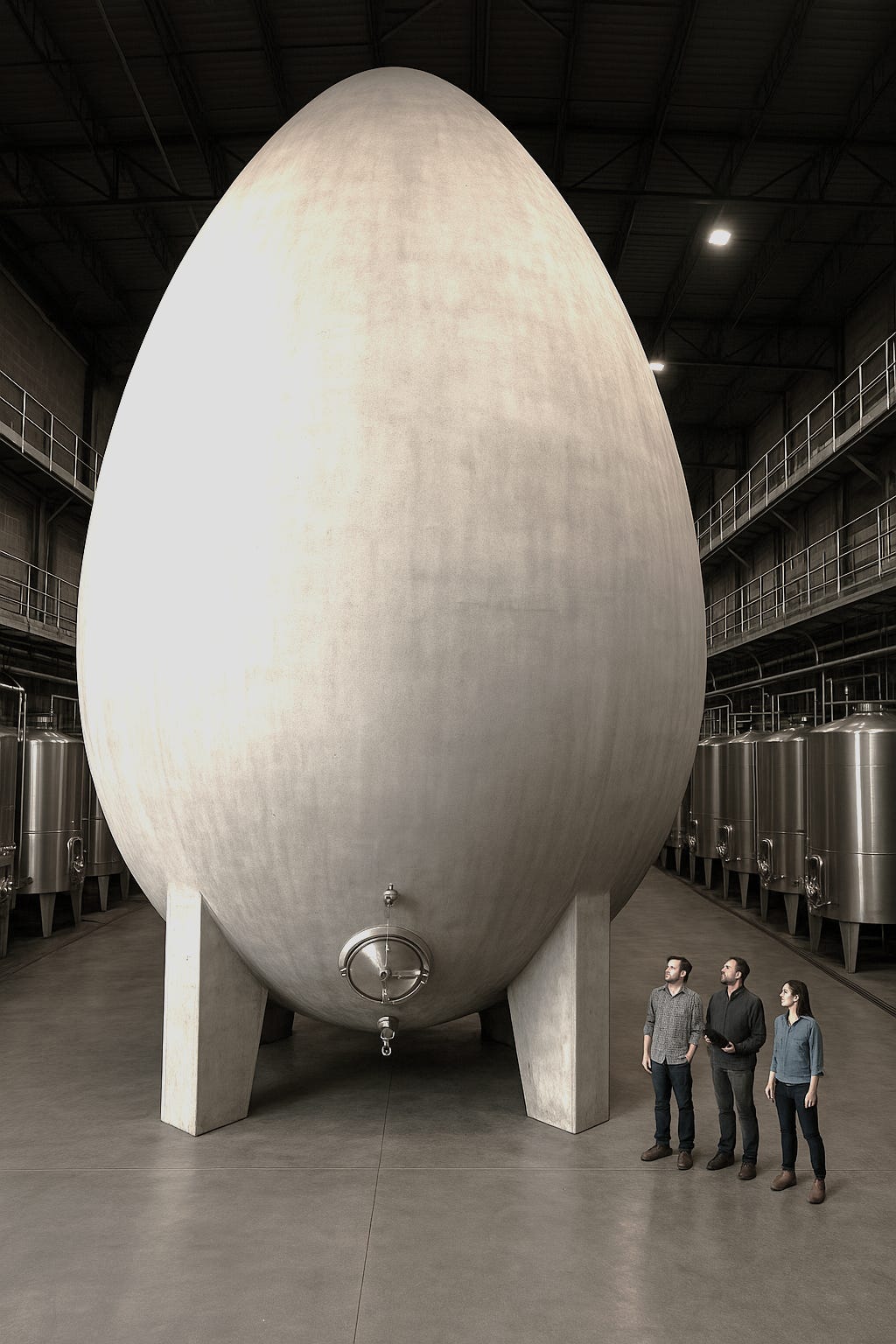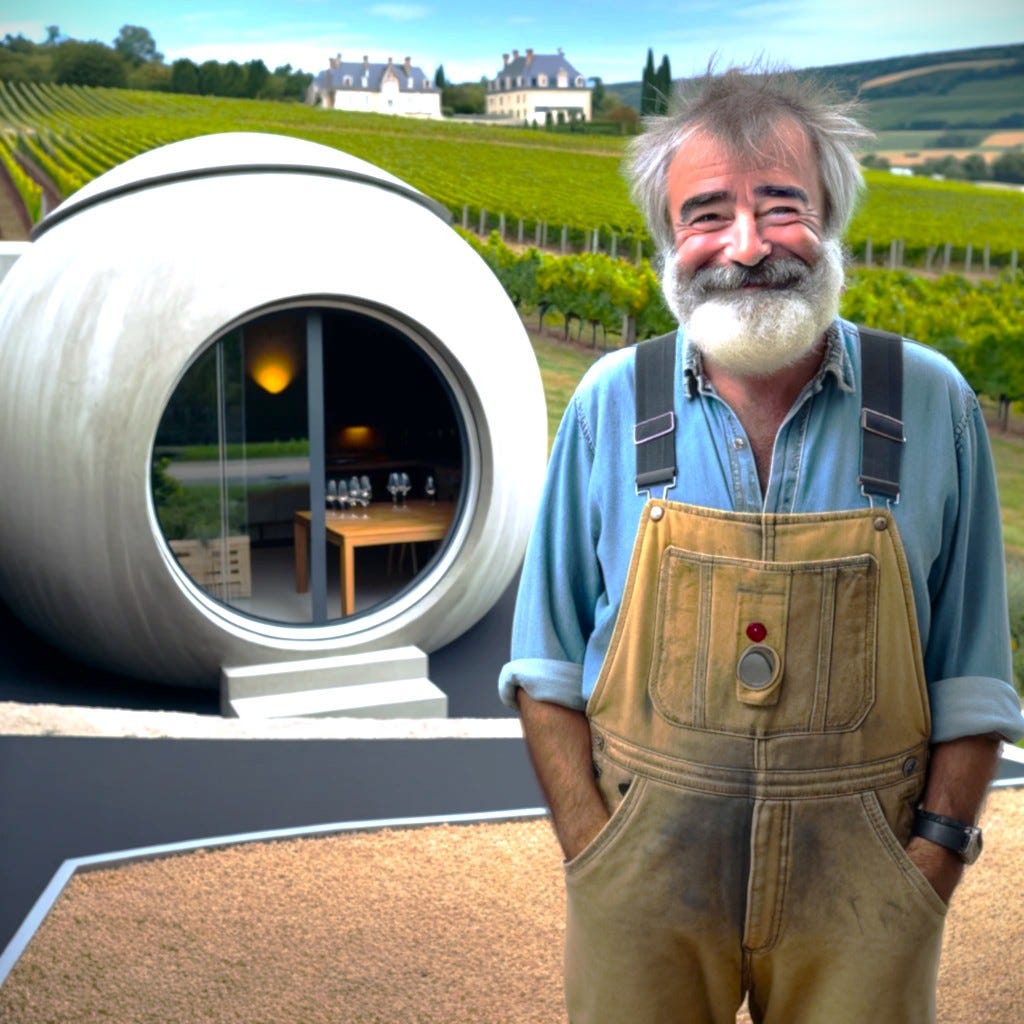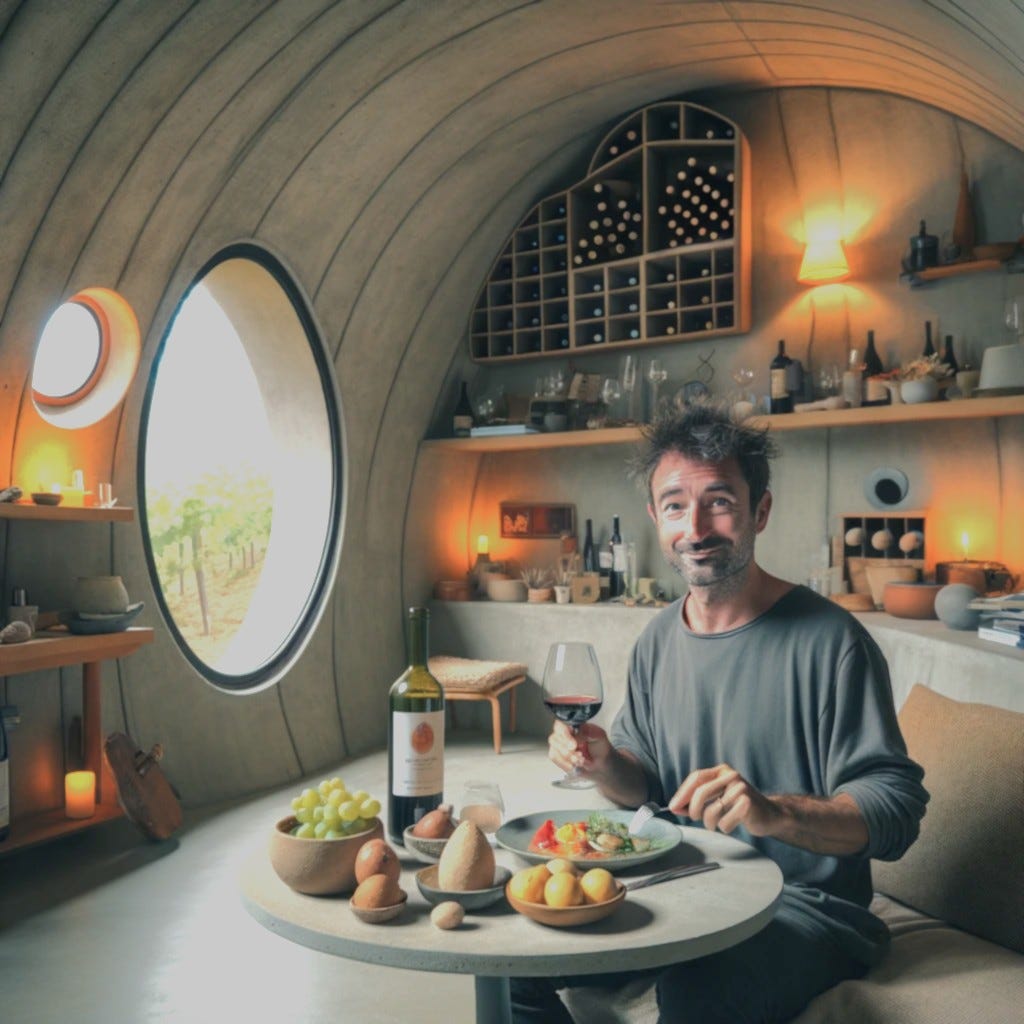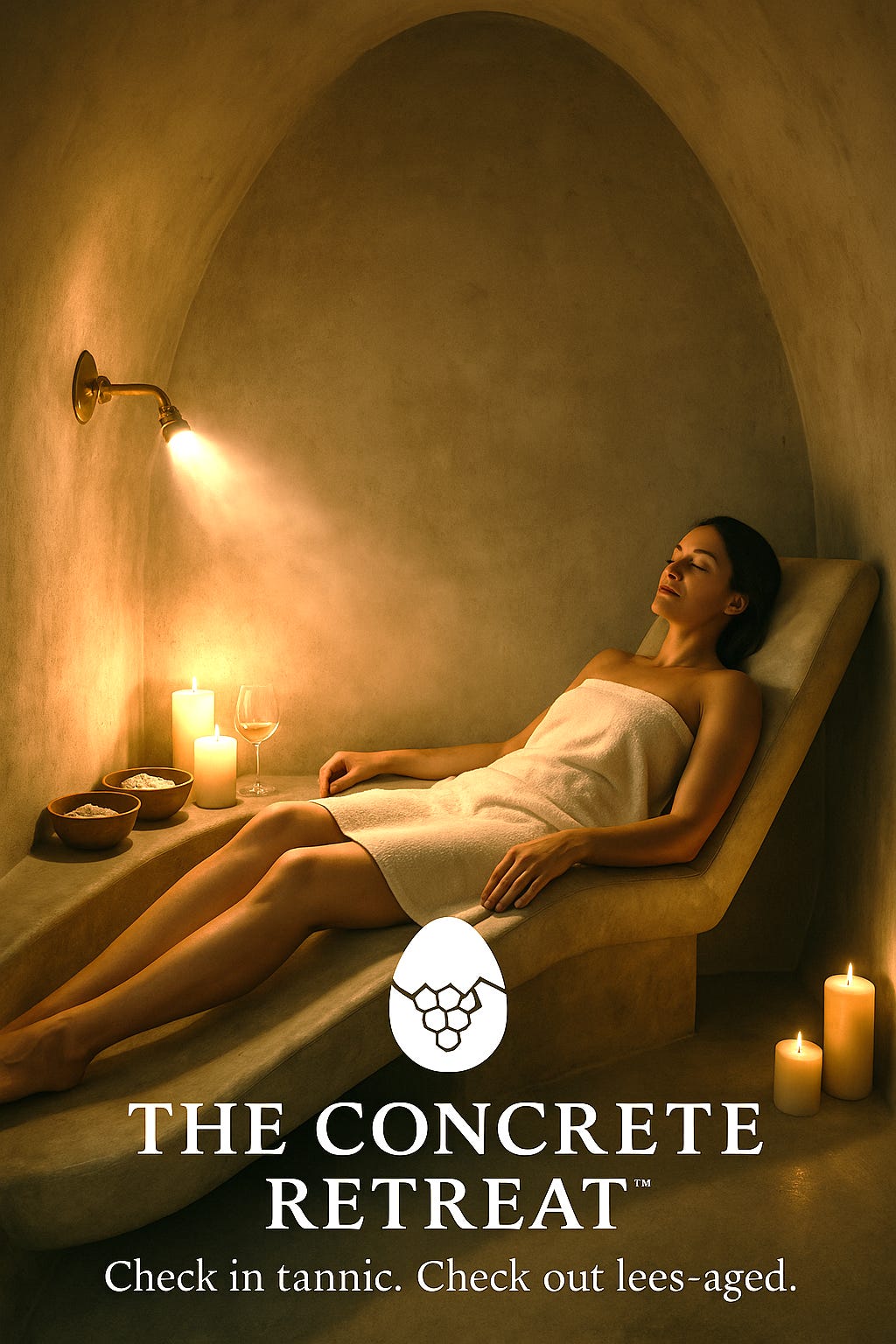From Roman rubble to mega-eggs and boutique spa pods. Yes, that’s right – the Indelible Wine Stain is here to find out how wine, and now people, are being aged in concrete.
These days it is common for a winemaker and winery to invest in concrete vats or the fabled concrete egg (not the Fabergé version). To move away from the influence of flavors gained from using toasted wood and to seek a purity of fruit leads many to experiment with concrete fermentation for wine.
Concrete vats deliver a subtle exchange of oxygen, which helps soften tannins and improve the mouthfeel of the wine, much like oak barrels do but without adding any flavors, preserving the character of the grape itself. Additionally, the thick walls of concrete vats provide excellent insulation, maintaining stable temperatures during fermentation and aging processes—much like that winter flab coat that we try to shake off each January.
The use of concrete vats in winemaking dates back to the early 20th century, although concrete as a material has been known since ancient times.
What is Concrete?
The word “concrete” derives from the Latin term concretus, which means “grown together” or “compounded.”
The material itself has been used for millennia, with its earliest known applications dating back to around 6500 BCE in the region that is now Syria and Jordan. The Mayans used it to build, as did the Greeks and Romans—some even believe the Pyramids were made of an early form of concrete.
The Romans significantly advanced concrete technology around 200 BCE by mixing volcanic ash with lime to create a durable, waterproof material. This blend was crucial for constructing long-lasting structures like the Pantheon and the Colosseum, which still stand today (and can be seen on their Instagram and Facebook pages).
What About Wine?
Many wineries have experimented with concrete vats, including Domaine de la Romanée-Conti in Burgundy, Château Valandraud and Cheval Blanc in Bordeaux, and Quintessa and Spottswoode in Napa.
The first documented use of concrete vats for winemaking can be traced back to the early 20th century, specifically to French vat manufacturer Marc Nomblot, who has been producing traditional concrete vats since 1922.
The innovation of egg-shaped concrete vats, however, was spearheaded by Michel Chapoutier in collaboration with Nomblot, with the first egg vat being commissioned in 2001.
Why Concrete?
Concrete vats offer several benefits:
Temperature Stability: Thick concrete walls buffer against rapid temperature changes.
Micro-Oxygenation: Concrete's semi-porous nature allows subtle oxygen exchange, softening tannins and improving mouthfeel.
Neutral Flavor Impact: Even though some sommeliers will lick the vats and wax poetic, concrete does not actually impart any flavors. It allows the true characteristics of the grape and terroir to shine.
Durability: Concrete vats can last for decades, making them a cost-effective long-term investment—some even being converted into living spaces for staff and visiting guests.
The Argentine Connection
Argentina embraced concrete vats in the mid-20th century, with many large tanks constructed to support the country’s growing wine industry.
Alberto Zuccardi, an engineer, began experimenting with concrete vats early on. He built some of the largest concrete vats in Argentina in the Maipú region, part of a broader innovative approach that included pioneering irrigation techniques.
By the late 1900s, stainless steel and oak barrels became more prevalent, and many concrete vats were abandoned. But in the 1990s, a resurgence began.
Sebastián Zuccardi, a leading figure in Argentine winemaking, led the revival. At Zuccardi Valle de Uco in Mendoza, concrete vats and amphorae are now central to their winemaking philosophy. These tanks enhance the terroir expression of the wines and hold thousands of liters each.
Marc Nomblot – The Original “Egg-head”
The Nomblot company remains a leader in the production of concrete vats.
Founded in 1922 by Etienne Nomblot in Ecuisses, Saône-et-Loire, France, the company originally produced concrete vaults and structures. Under Etienne’s grandson Marc, the company shifted focus in the 1980s to specialized wine vats.
In 2001, Marc collaborated with biodynamic winemaker Michel Chapoutier to create the first egg-shaped fermenter. Inspired by ancient amphorae, the design promotes continuous circulation during fermentation and enhances texture without adding flavors.
The egg shape quickly gained favor among premium producers in Burgundy, Bordeaux, California, and beyond.
In 2011, the company was acquired by Bonna Sabla. In 2018, Franck Fenyes and his wife Céline purchased the brand and moved production to Torcy, continuing the Nomblot legacy.
The Concrete Retreat
One company has found a way to use abandoned concrete eggs and vats for more than just fermentation—they’re aging people in them.
At The Concrete Retreat, guests check in rough and tannic and check out soft, structured, and gently aged.
In the hills of Mendoza, winemaker François Vasquez has turned winemaking innovation into a luxury lodging concept. Guests now sleep inside decommissioned concrete vats and egg fermenters.
Outfitted with cots, bidets, minimalist lighting, and optional lees foot baths, these pods are the ultimate oeno-spiritual escape.
“People emerge different,” says François. “Fuller-bodied. Improved structure. Less volatile acidity in their very being.”
Guests describe the experience as meditative, cozy, and very slightly musty. Each egg is climate-controlled, naturally silent, and just porous enough to allow gentle oxygen exchange into the soul.
“I emerged like Chardonnay on lees: textured, integrated and smelling faintly of crushed stone.”
—Léon Graciuex, Retreat Guest #003“At first I wasn’t sure about sleeping in a fermenter, but after three nights I came out smoother, more structured, and finally understood my own body’s malolactic conversion.”
—Grantham Parstable, Retreat Guest #042
Spa Services for the Skin-Contact Curious
Building on its success, The Concrete Retreat launched the Concrete Egg Beauty Spa. Guests are sealed into upright eggs for vinotherapy sessions involving grape seed scrubs, lees compresses, and a Sauvignon Blanc-infused mist cycle.
Spa Director Amélie Weevil explains: “We detoxify. We clarify. We mystify. We reduce volatile acidity of the soul.”
While some scoff at the idea of sleeping in a fermentation tank, others emerge transformed.
Concrete doesn’t just make wine purer—it makes people better. Softer. More mineral-driven. More expressive of place.
And as François says: “In the end, aren’t we all just some juices inside of a sinewy, bone-vessel that gives us structure?”
Well, François, we would say to that — “No, we aren’t, you strange madman.









